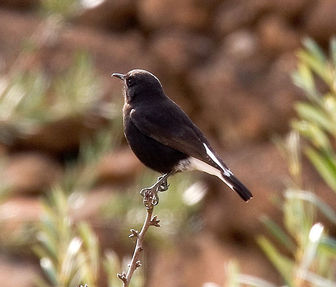Black Wheatear
This large 16-18 cm long wheatear breeds on cliffs and rocky slopes in western north Africa and Iberia. It is largely resident and nests in crevices in rocks laying 3-6 eggs.

Original source: Martien Brand from Mariënberg, The NetherlandsOther versionsCropped from original
Author: Martien Brand from Mariënberg, The NetherlandsOther versionsCropped from original
The Black Wheatear is classified as Least Concern. Does not qualify for a more at risk category. Widespread and abundant taxa are included in this category.
The Black Wheatear, Oenanthe leucura, is a wheatear, a small passerine bird that was formerly classed as a member of the Thrush family Turdidae, but is now more generally considered to be an Old World flycatcher, Muscicapidae. This large 16-18 cm long wheatear breeds on cliffs and rocky slopes in western north Africa and Iberia. It is largely resident and nests in crevices in rocks laying 3-6 eggs. More
range, but the Black Wheatear has a black inverted "T" on its white tail, whereas White-crowned has only a black centre to its tail. The Black Wheatear never has a white crown, but young White-crowned Wheatears also lack this feature. Diet / Feeding The food of this wheatear is mainly insects. Song / Vocalization It has a loud thrush-like song. Copyright: Wikipedia. More
Black Wheatear should have a black bar like a Northern Wheatear Oenanthe oenanthe but not having had time to check any books before we set out we were not absolutely certain about this. White-crowned Black WheatearThe wheatear seemed quite tame and clearly favoured a rusty car chassis in the salubrious surroundings of a rubbish-filled pit. Shortly after, it moved off towards the pumping station. More
Black Wheatear determination Similar species Muscicapidae Black Redstart | Black Wheatear | Black-Eared Wheatear | Blue Rock Thrush | Bluethroat | Brown Flycatcher | Canary Islands Chat | Collared Flycatcher | Desert Wheatear | Finschs Wheatear | Isabelline Wheatear | Moussiers Redstart | Nightingale | Northern Wheatear | Pied Flycatcher | Pied Wheatear | More
For the purposes of our bird news services, Black Wheatear is classed as Mega: species which have not yet occurred in the British Isles or are exceedingly rare, or are otherwise highly desirable. More
The similar Black Wheatear, Oenanthe leucura, also breeds in the western part of the White-crowned Wheatear's range, but the latter has a black inverted T on its white tail, whereas White-crowned has only a black centre to its tail. The Black Wheatear never has a white crown. This species mainly eats insects. This wheatear has a loud song, more varied than most of its relatives and often including mimicry. Copyright: Wikipedia. This article is licensed under the GNU Free Documentation License. It uses material from Wikipedia. More
The black wheatear (Oenanthe leucura) is a bird that lives in semi-desert areas of southern Spain and the coastal strip of north-east Africa. The male is predominantly black with a white rump and with black and white patterning on his tail, see Figure 1. The female is similar, except that she is dark-brown rather than black. Adults are about 18 cm in length and have a mass of 35-40 g. They are monogamous and lay 3-6 light blue eggs which have red/brown speckles. More
* One of the characteristics of a black wheatear nest is that it contains a pile of stones near the entrance. * White crowned black wheatear oenanthe leucopyga A new bird for most of the group seen at Philae and the High Dam. * She offered them a plate of pie each and they ate with relish - wheatear pie was considered a great delicacy. More
Black Wheatear comes in to land - stunning birds and resident here too! Village of Montejaque Water Pipit Water Pipit Blue Rock Thrush displaying (male) Spanish Ibex Spanish Ibex - bock Sunny days - what to do? More
Black Wheatear has been excluded due to its large-headed appearance, slightly bulkier size and longer bill and tarsus (Wallace, 1983); this species also has p5-p8 emarginated (like Eastern Pied Wheatear) (Cramp, 1988) and has less white on the rump. In addition, unlike the basalt wheatears both these species have duller and browner female plumages. More
View all pictures of White-crowned Black Wheatear View all pictures of White-crowned Black Wheatear show section Past records (1) This species has been reported in the following areas (Bird News Extra subscribers can click a county name for more details): Suffolk show section Products featuring White-crowned Black Wheatear (7) BWPi DVD-ROM 2.0 (DRBWP: £135.95) iDentify European Birds (disk only - mp3 player required) (AGDE: £38. More
Black Wheatear in Spain Photo of Black Wheatear Population and distribution of Black Wheatear in Spain News and information on Black Wheatear in Spain English-Spanish-Catalan translation of Black Wheatear * Black Wheatear : collalba negra : c More
English: Black Chat, Black Wheatear, Common Black Wheatear Spanish: Collalaba Negra, Collalba Negra Estonian: must-kivitäks Basque: Buztanzuri beltza, Còlit negre Finnish: Mustatasku Faroese: Sorgarstólpa French: Traquet rieur Irish: Clochrán dubh Galician: Còlit negre , Pedreiro negro Hebrew: סלעית שחורה Icelandic: Urðardepill Italian: Monachella nera Japanese: kurosabakuhitaki Japanese: クロサバクヒタキ Latin: Oenanthe leucura Lithuanian: Juodasis kultupys Maltese: Kuda Sewda More
Black Wheatear, Seville province, Andalucia, Spain, Near Benacazon (37°21′N, 6°11′O) 7th March 008 © Stephen Daly Birding and Wildlife Tours Send this as a postcard Black Wheatear - Black Wheatear, Andalucia, Spain, Near Ronda May 2008 © Stephen Daly Birds of the Iberian Peninsula Black Wheatear - Black Wheatear, Andalucia, Spain, Cortes de la Frontera June 2009 © Stephen Daly Guided Birding More
Family : Muscicapidae
Genus : Oenanthe
Species : leucura
Authority : (Gmelin, 1789)

